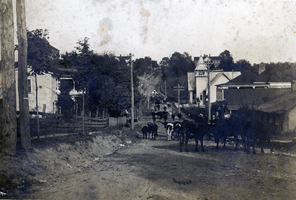
The emergence of market-based agriculture in the United States during the early 19th century created new opportunities for farmers and merchants. Driving livestock from rural farms to urban markets required passable roads and people to herd cattle, sheep, hogs, and even fowl. Before the advent of mass livestock shipments via rail in the 1850s, animals bound for urban slaughterhouses were driven on the hoof from farms, to feedlots, and then to the eastern cities. The people who drove the animals were both livestock raisers and professional drovers. In Western Virginia, large-scale animal drives persisted into the latter part of the 19th century because of delays in opening rail routes through the mountains.
Although animals were driven from farms throughout the state in all periods of its history, the present Eastern Panhandle counties played an early part in the improvement of American cattle raising and became a significant link in the food chain between vast Midwestern prairies and Eastern markets. As early as the 1750s, the farms along the South Branch of the Potomac River were well known for their cattle and the families, such as the Pattons, who raised and sold them. As large cattle operations moved west into Ohio and Illinois in the mid-19th century, West Virginia’s roads became livestock highways. Drove yards and inns sprouted at regular intervals to serve the drovers and to pasture and water the stock. Brooke County’s Drover’s Inn, a local landmark now on the National Register of Historic Places, survives from this era. The National Road, which cut through the state’s Northern and Eastern panhandles, became a leading 19th-century cattle trail. Farmers in West Virginia’s more mountainous areas relied upon back roads that were little more than trails to drive cattle to such cities as Elkins and Pittsburgh, Pennsylvania.
During the 20th century, trucks replaced trails and rails as the prime movers of West Virginia livestock, and the long drive from farm and pasture to market was replaced by the short drive to town or the pickup by modern-era diesel-powered drovers.
This Article was written by David S. Rotenstein
Last Revised on November 21, 2023
Related Articles
Sources
Henlein, Paul C. Cattle Kingdom in the Ohio Valley 1783-1860. Lexington: University Press of Kentucky, 1959.
MacMaster, Richard K. "The Cattle Trade in Virginia, 1760-1830," in Robert D. Mitchell, ed, Appalachian Frontiers. Lexington: University Press of Kentucky, 1991.
Whitcomb, Robert & Judith Whitcomb. Mountain Cattle Drives. Goldenseal, (Summer 1998).
Cite This Article
Rotenstein, David S. "Drovers and Livestock Drives." e-WV: The West Virginia Encyclopedia. 21 November 2023. Web. 24 April 2024.


Comments?
There aren't any comments for this article yet.
Click here to read and contribute to the discussion →